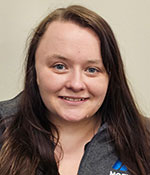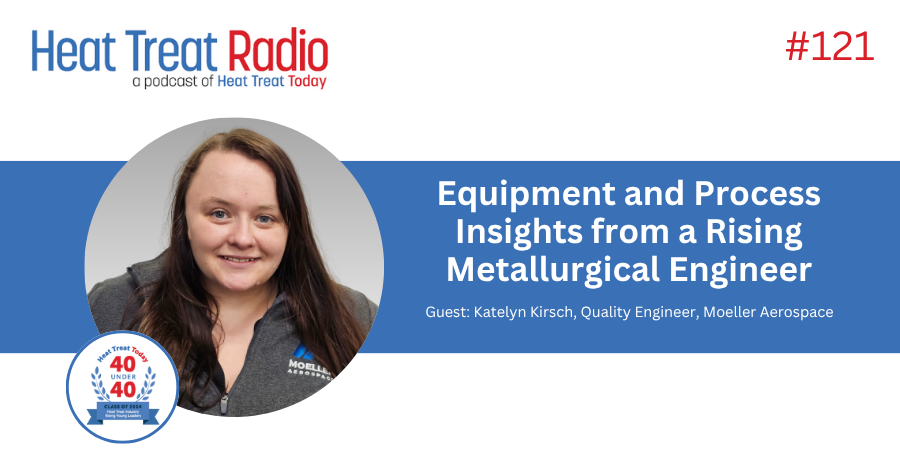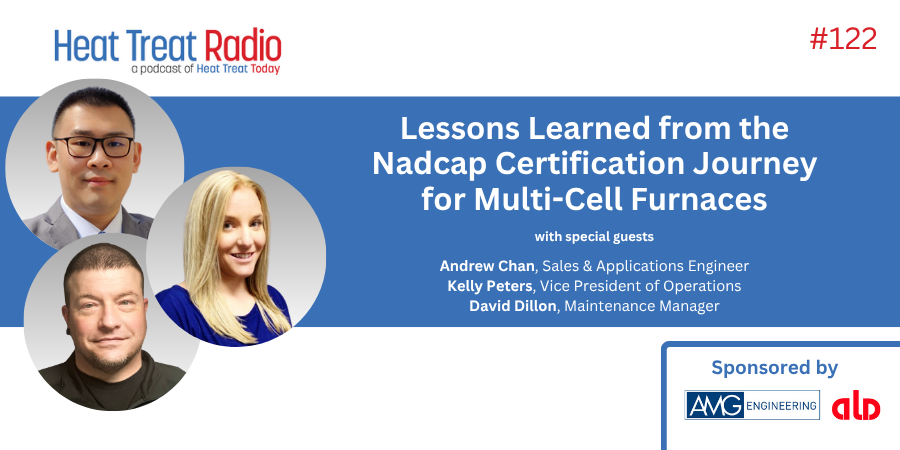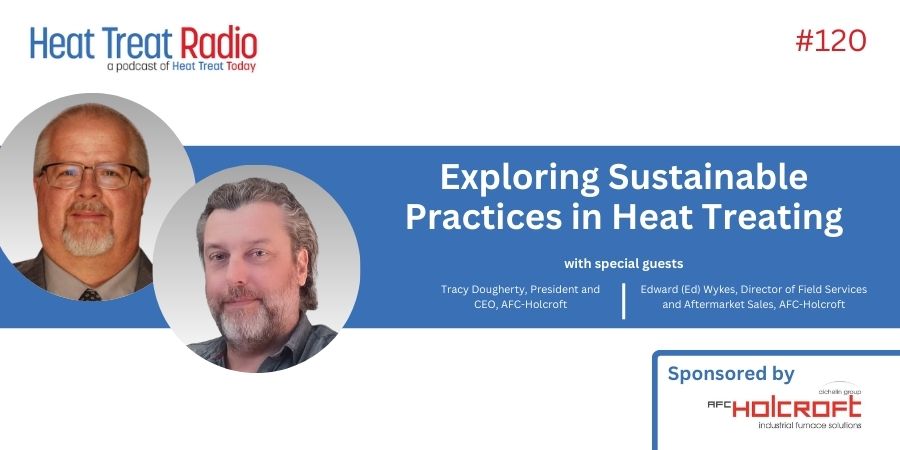In this Heat Treat Radio episode, join host Doug Glenn as he talks with Katelyn Kirsch, a metallurgical engineer with extensive experience in the heat treating industry. Katelyn discusses her career journey, including roles at Huron Casting, Federal Screw Works, and Moeller Aerospace. She highlights her responsibilities in integrating new equipment and processes, managing thermal processing, and setting up a metallurgical lab. Katelyn also shares insights on the challenges of implementing new processes, the importance of hands-on experience, and the benefits of bringing processes in-house for improved turnaround times. The episode provides valuable perspectives for professionals in the heat treating field.
Below, you can watch the video, listen to the podcast by clicking on the audio play button, or read an edited transcript.
Introduction (00:00:54)
Doug Glenn: So let me introduce you to Katelyn Kirsch. I’m not going to do too much in the way of an introduction, except to mention the three companies that I’m aware of that you’ve worked at and then I want to ask you a few questions about your background, as well.
From what I understand, you have a degree in metallurgical engineering from South Dakota School of Mines and Technologies and a master’s degree from Strayer in project management.
Huron Casting is one of the companies you worked for, then Federal Screw, and then most recently Moeller Aerospace. First off, I want to welcome you, and now can you tell the listeners and viewers a little bit more about what you did at each of these companies?
Katelyn Kirsch: At Huron Casting, my first job out of college, I was a metallurgist. While I was there, I focused on overall quality of our product, from the point of alloying into a furnace to where we cast it through our heat treat processes, ensuring the chemistry is good because hardnesses are everything.
For Federal Screw, I was the metallurgical lab supervisor. I ran our metallurgical lab, managed our thermal processing on our neutral hardening quench temper furnace, our subcritical anneal, and all of our induction processes in-house, and then managed the quality from all of our sub-tier heat treaters that we had to use while I was there.
At Moeller, I’m currently in the quality engineer role, but I’m helping them bring in their metallurgical lab and also bringing in heat treat and potentially brazing.
Doug Glenn: I do want to mention to the listeners and viewers of this podcast that Katelyn is one of the 40 recipients of our Heat Treat Today 40 Under 40 award for 2024. Congratulations on that. One of the rising young leaders in the industry, which is very good.
Federal Screw (03:26)
I would like to ask you a little bit more about your time at Federal Screw, because I understand when you were there, you were involved. I want our listeners to kind of get inside of your head on how it works inside a manufacturing plant that’s doing thermal processing. How do people think about integrating new processes and new products? You were responsible for introducing a new part line at Federal Screw.
Katelyn Kirsch: While I was there, we already had our neutral hardening and temper line, and we had one induction hardening process. When I started, we were getting ready to bring in another induction hardening process on half shaft axle bars. So, we got the equipment probably about a year and a half after I started, and I was responsible for getting the line running and conforming parts off our heat treat line.
I’ve done induction before, so I figured this isn’t going to be too difficult — I was sorely mistaken. It was a much bigger project than any of us anticipated. We were bringing parts in from the incumbent, which was our customer as well. They had been doing the parts for 40 years, so they knew exactly how to do this. They’d been doing it, and we were coming in and right off the bat trying to get going.
With Covid and everything at the time, it really shrunk our developing process. We were on an expedited timeline trying to get it going. So, we just had to throw it at the machine. We were going to try “x, y, and z” and just see where it ended up and start tweaking from there. We were trying to get to know the equipment while we were developing. It was a long, grueling process — many long nights.
Doug Glenn: I can imagine. Were you involved in the selection of the induction equipment or was that already done when you got there?
Katelyn Kirsch: They had selected the equipment before I started, but beyond that, I was involved with the selection of lab equipment, completing the runoffs, and working with the equipment manufacturer to make sure we had everything we needed.
Doug Glenn: That whole process was painful primarily because of how quickly you had to have it up and running, correct? You didn’t have time to really thoroughly vet it.
Katelyn Kirsch: Yes, it was a very expedited process. After we had the equipment set up, we kept hitting one hurdle after another, where we thought, “Okay, this isn’t working, I have to pass this hurdle.” We would come up to a speed bump, fix it, and keep moving forward.
Doug Glenn: How many people were involved on the team at Federal Screw in the integration of this new induction process?
Katelyn Kirsch: On the actual heat treat process itself, it was primarily me, and then our engineering manager or manufacturing manager set up the rest of the line. We were trying to set up the machining process because we were trying to do everything at once, like a robotic line. They load parts in the machine, and it just continues through until the parts leave the temper furnace.
Doug Glenn: So you were trying to automate the whole thing?

Katelyn Kirsch: Yes, we were trying to handle the manufacturing side, and we had a program manager who was trying to help on the heat treat side to at least arrange people. We had people to help with testing and on the mechanical side if I needed help trying to work on a machine. We had a couple programmers in charge of the automation of the robots, but it was primarily myself on the specific heat treat side, and then my lab techs trying to run product, test product, run more samples, and test more samples.
Doug Glenn: Other than the internal team, did you find yourself utilizing any resources external to Federal Screw, besides the company that you were doing the work for?
Katelyn Kirsch: Besides the company we were doing the work for, we didn’t really need to outsource until we tried eliminating heat treating a certain area of the part. We were getting quench crack failures on these parts — it was almost just inherent to the process of how the part had to be heat treated — and there were certain methods you could use to mitigate that. You could try to eliminate for a while, but it was something that was inevitably going to happen. It was a very thin section, and when we would heat that up to harden and quench it — I’m pretty sure you know what’s going to happen.
Doug Glenn: As we say, it’s not all it’s cracked up to be. Which part was it?
Katelyn Kirsch: Half shaft axle bars.
Doug Glenn: Before we move away from discussing Federal Screw, as you look back on that experience, were there any major lessons that you brought with you to Moeller — anything that you learned about the metallurgical industry, your specific job, or metallurgical labs?
Katelyn Kirsch: Going through school, you’re going to learn all of your technical knowledge, all the theories that you’re going to apply throughout heat treating. But working especially at Federal Screw, you learned the most from the operators. Becoming a good friend with my operators at Federal Screw, I learned more about the heat treat process, like what I would need to tweak in a furnace. I know what a book is going to tell me to do, but a book and practice are not always the same thing.
Doug Glenn: Are you talking about the induction equipment operators?
Katelyn Kirsch: Yes, induction equipment operators, like a hardening furnace operator, temper furnace operator. On the induction machine, I was so integrated in that process, I could get my data from a test bar. I would know if I needed to up my amperage or take it down. I was so involved in that process that I knew more than our operators because it was just a robot running it, essentially. If I was gone, I was just a call in to the manager of the line to say, “Go up, take out 5%, test it. It should be right where you want it to be.”
Doug Glenn: Were you able to monitor equipment remotely?
Katelyn Kirsch: For the equipment they purchased for that line, I was able to log in remotely through TeamViewer into the computer system and help them recover from a failure. If I was off-site or at home, if the machine crashed or if they were getting errors, I was able to log in and see what was going on with the machine. I could give them direction and tell them what to do. Most of the time it was a phone call to tell them, “Hey, watch the robot, make sure I don’t crash into anything and break it.” Then I’d start moving everything from home.
Doug Glenn: Was it actually a robot or was it more just like a scanning station?
Katelyn Kirsch: It was a gantry system. The parts would leave a cleaning line and would basically just roll over to the machine. A gantry would pick them up, bring them, put them in the machine. The machine itself is a scanning induction machine. So, it would do the hardening, then the gantry would take those parts out, and put new ones in.
Doug Glenn: I assumed you had a scanner, an induction scanner of some sort, since you were talking about half shafts. So, it was basically a gantry system to load and unload, and then when it unloaded, it went straight from there to a temper furnace.
Katelyn Kirsch: It went back to another conveyor, and the conveyor rolled straight over to another robot that would pick them up on another conveyor that would take them over to the temper furnace.
Doug Glenn: Did the robots load a basket full for the temper furnace?
Katelyn Kirsch: It was a continuous temper, so it had slots that the bars would rest in.
Moeller Aerospace (13:08)
Doug Glenn: Let’s move over to Moeller. Tell us about what you have been tasked with at Moeller?

Katelyn Kirsch: At Moeller, I’m a vane nozzle QE. But one of the main reasons Moeller hired me was to help bring in the metallurgical lab first.
Our quality director came from another company and they had everything in-house between their metallurgical lab, coding, heat treat, brazing, etc. So they didn’t have to outsource much coming in. So we were able to start building our plan for our metallurgical lab. We’re a couple months away from doing our first audit — I’m excited.
Doug Glenn: What are you being audited for?
Katelyn Kirsch: With aerospace, you have customer-specific audits and then you have Nadcap audits. With our primary customer, who’s probably about 80% of our business, we are going to be doing their audit first so we can start auditing their product in-house, and then we’d be needing approval after that.
Doug Glenn: So you’re involved now with the Nadcap audit. Will the Nadcap be for heat treat or Nadcap or for a metallurgical lab for testing.
Katelyn Kirsch: It’ll be the metallurgical lab first.
Doug Glenn: Have you already purchased most of the equipment for the metallurgical lab?
Katelyn Kirsch: Yes, that was my first task. We’re focusing mainly on metal graphic mounts first — we’re not going to be getting into hardness testing yet. But we purchased all that we needed and that was delivered probably about midway of last year. We finished hooking it up and water plumbing, and completed all our venting in November of this past year. So we’ve been able to get in and actually start working with the equipment, getting prepped for the audit, making sure everything’s aligned, and that we are not missing any piece of equipment.
Doug Glenn: Do you do your own heat treating there for this part.
Katelyn Kirsch: We will be —we don’t have in-house heat treat yet.
Process of Purchasing Lab Equipment (17:04)
Doug Glenn: Tell me a little bit about the process for purchasing the lab equipment. How many people were involved?
Rehearse with us on what it takes and the difficulty of the process.
Katelyn Kirsch: It was actually pretty easy on my part. Coming from the automotive sector where with a very high-volume lab, I knew the nuances of equipment purchasing and of training people in a lab. In my opinion, one of the hardest things to train is teaching how to grind and polish a mount. It’s hard to do, it’s very finesse. Even people who have been doing it for 20-30 years can mess it up if they’re doing it by hand.

Essentially, I was given a budget after I initially picked out equipment and I was told keep it under $X amount. I picked the equipment, sent the list off to my boss. He went to the CEO and had to sign off for the capital purchase, and then we got everything ordered.
Doug Glenn: Did you go primarily with equipment you were comfortable with from the past or did you shop around much?
Katelyn Kirsch: A little bit of both — there were two manufacturers that I’ve worked with in the past that I liked, and I decided to go with a manufacturer that was more stateside so I could get real time help, if I needed it. Also, their price range enabled me to get more of the equipment that I would need and try to keep it under budget.
Doug Glenn: Being somewhat stateside was important here for service and replacement parts or whatever you needed. How large is Moeller, employee-wise?
Katelyn Kirsch: I think we’re about 270-300 employees.
Doug Glenn: So you have purchased testing equipment, you have it in place, and you’re at the point now where you can start getting the certification that your customer requires. You’ll get that down and then move onto a general Nadcap certification.
Have you done one of these audits before?
Katelyn Kirsch: Not specifically this audit. In the automotive industry, I had to do the CQI-9 self-assessment, and I was always involved with the audits when we had our INTF audit at Federal Screw. I had to walk them through the heat treat process and the lab side of that audit.
Doug Glenn: Is this the first lab audit you’ve completed?
Katelyn Kirsch: Yes, this is the first lab-specific audit. I’ve reviewed their specifications, so I think it shouldn’t be too bad.
Doug Glenn: Are you in the midst of it now? Where are you in the process?
Katelyn Kirsch: We’re prepping for the audit currently. We’re aiming for a march audit date. So we’re in the final stages of documentation.
Doug Glenn: That’s coming right up. Is there anything else you’d like to say regarding the audit process or equipment selection process that you think would be helpful to other people that may be in your shoes? Any lessons learned?
Katelyn Kirsch: If it’s something that you’re not familiar with, if you have a colleague that has equipment that you can get your hands on, or if you’re in the position that we’re in where we are trying to bring processes in-house, and you have a good relationship with your customer who might have a lab, see if you can get in and work with and see that equipment. I know there are many companies that have satellite labs that you can see the equipment firsthand.
That’s what drove much of my purchasing on the lab equipment itself was knowing and being familiar with what works well, what we would need to make it an easy training process, and make it as smooth as possible.
Doug Glenn: The drive to bring these processes in-house was basically control and timeliness. Were you not able to find labs in the area that you were comfortable with?
Katelyn Kirsch: No, it’s primarily the turnaround time. In aerospace, when we go to work on what we call an MPI, which is essentially a product launch, we lose competitiveness. We do electrical discharge machining (EDM) in-house. When we have to send those out for a lab cut up —the lab that we use could take 2–5 weeks. You get stuck waiting and hoping it comes out good, and then possibly find out it failed and we have to go back and change it.
It’s the same reason we’re bringing heat treating in-house and then brazing, to have a quicker turnaround time, and it’s easier to diagnose. We could run a sample; if it fails, we can go back and run it again.
Advice for the Next Gen of Metallurgy Professionals (23:15)
Doug Glenn: You’re one of the younger professionals in the industry. Is there anything you would say to younger people still high school or college age that are thinking about getting into either metallurgy, metals, metals industry, thermal processing etc. — any advice?
Katelyn Kirsch: If it’s something that you’re passionate about, go for it. The schooling might be scary, but it’s very rewarding. I felt good about school all the time. It was something that you could put your hands to and see what you did.
When you get into the industry itself, become best friends with your operators. I’m a big proponent of knowing you can learn anything from A to Y in your textbook, but that last letter, Z, you’re going to get from your operators who have been running the processes. They know more about what they can do, what’s happening in their equipment, and what’s happening in their furnaces that your book is not going to tell you. It’s going to be that practice that’s going to help put the final polish on your process and getting performing parts.
Doug Glenn: Speaking of polishing, what drew you into metallurgy?
Katelyn Kirsch: I started off my schooling as a mechanical engineering major. I was in my third year of schooling and I was bored. I didn’t have joy in my homework. I didn’t really see myself being a mechanical engineer. I didn’t see myself being able to have a career. As a mechanical engineering major at South Dakota School of Mines, we have to take a metallurgy class. Once I took that class, I thought it was really interesting. You have your basically forensic science and then going to failure analysis, and I thought it was interesting. So, I talked to the head of my department, and I switched majors. Honestly I was overjoyed — it was the best decision I’ve ever made.
Doug Glenn: What did you enjoy about it?

Katelyn Kirsch: I learned really well based on theory and how to derive from where you came from, and metallurgy is a lot of deriving to find your problem. There’s no one key solution in metallurgy to fix a problem. I love learning that way. I love that kind of process.
Doug Glenn: Putting all the parts together, and figuring it all out. It’s pretty interesting. I often find when we do a series of episodes called NextGen, which you would fit in nicely, we talk more about your personal experience, and I’m always fascinated that when we ask people, “Did you ever think there was so much to metallurgy?” It’s just fascinating when you get right into it. There’s a lot to be learned, and there’s a lot of mystery out there still about how things work.
Katelyn Kirsch: They had three different branches for the major. You had your physical metallurgy, you had your extractive metallurgy, and then your pyro metallurgy, essentially your heat treat processing. I did very well in the extractive classes, but I disliked it. I got great grades in those classes, but I did not like them. It was more of the physical and the processing side of metallurgy that I was keen on.
Doug Glenn: That’s very good. Katelyn, thank you very much. Thanks for spending some time with us. I know you probably have to get back to Moeller and start actually doing some real work getting ready for your Nadcap audit.
About the Guest

Quality Engineer
Moeller Aerospace
Katelyn Kirsch has a Bachelor’s degree in Metallurgical Engineering from South Dakota School of Mines & Technology and a Master’s degree in Project Management from Strayer University. Her time in the industry began at Huron Casting Corporate Services as a metallurgical engineer. Through her work experiences, Katelyn has gained technical knowledge across many disciplines: various processes for making steel in a continuous casting mill and shell casting foundry; heat treating for components from different industries, and multi-industry metallurgical inspections. She has developed strong skills in the lab including handling testing production samples, failure analysis and material characterization, and Production Part Approval Processes (PPAP), such as PFMEA development.
Moving from her leadership position at Federal Screw Works to join Moeller Aerospace, Katelyn is on track to assume the leadership of a new metallurgical lab in development, followed by the planning of all equipment being installed, in order to begin validation and certification of the testing process. Her current role at Moeller Aerospace is quality engineer, however, her projects will include the establishing of heat treating and other operations in the coming years. Kaitlyn Kirsch was a Heat Treat Today 40 Under 40 class of 2024.







